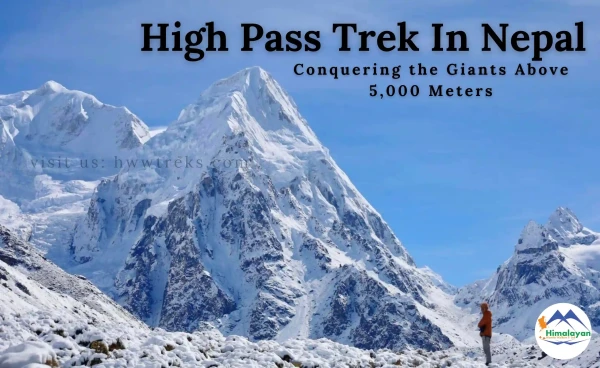- 12/07/2025
- Tags: Manaslu circuit trek
- Himalayan Wander Walkers
Manaslu Trekking and Tips
Manaslu region is locally known for Nubri, upper Gorkha district of Gandaki Province. The Manaslu Trek route is located between the Annapurna Circuit Trekking region in the west and Tsum Valley in the east. It is also well known for the Manaslu Circuit Trek (MCT). Manaslu Circuit Trek used to be a camping trek, but now this trek has become easier because of the increase in tea houses and improved trails. Manaslu trekking is one of the most popular trekking destinations in Nepal, and it is a restricted trekking area. Nowadays, the Manaslu Trek is referred to as the New Annapurna Circuit Trek.
Himalayan Wander Walkers is a Nepal-based local trekking operator that provides authentic and updated information to all travelers and trekkers who visit Nepal for trekking purposes. You may have already done some research or study for trekking in the Manaslu Region, but still, not every blog and guidebook is similar. So, we came up with updated information for trekking in Manaslu Region.
We hope this Manaslu trekking and travel guide will help you plan your trek in the Manaslu Region. Let’s go below for more details about trekking in Manalsu, and we have categorized them into different titles.
Contents [hide]
- 1. Manaslu Trekking Permits and their Costs
- 2. Starting and Ending point for Manaslu Circuit Trek?
- 3. Manaslu Circuit Trek day by day itinerary
- 4. Trekking Guides and porters for Manaslu Circuit Trek
- 5. 9 Reasons to choose Manaslu Circuit Trek
- 6. Best treks in Manaslu Region
- 7. Variation of Manaslu Circuit Trek
- 8. Best season for trekking in Manaslu Region
- 9. Network and Electricity availability in Manaslu Region
- 10. Top tips for trekking in Manaslu Region
- Review of Manaslu Trek
- Join Our Fixed Departure for Manaslu Region Trek
1. Manaslu Trekking Permits and their Costs
1) Manaslu Restricted Area Permit
Remember, it is mandatory to have at least two trekkers to get the Restricted Area Permit for Manaslu from the Department of Nepal Immigration. A restricted trekking permit for Manaslu is only obtained through authorized Nepalese trekking companies. A restricted area permit (RAP) costs USD 100 for the first week from September to November. If you are spending more days than a week, the additional per day costs USD 15. The fee for RAP will be less from December to August, which costs USD 75 for the first week. An extension or additional permit thereafter is USD 10 per day.
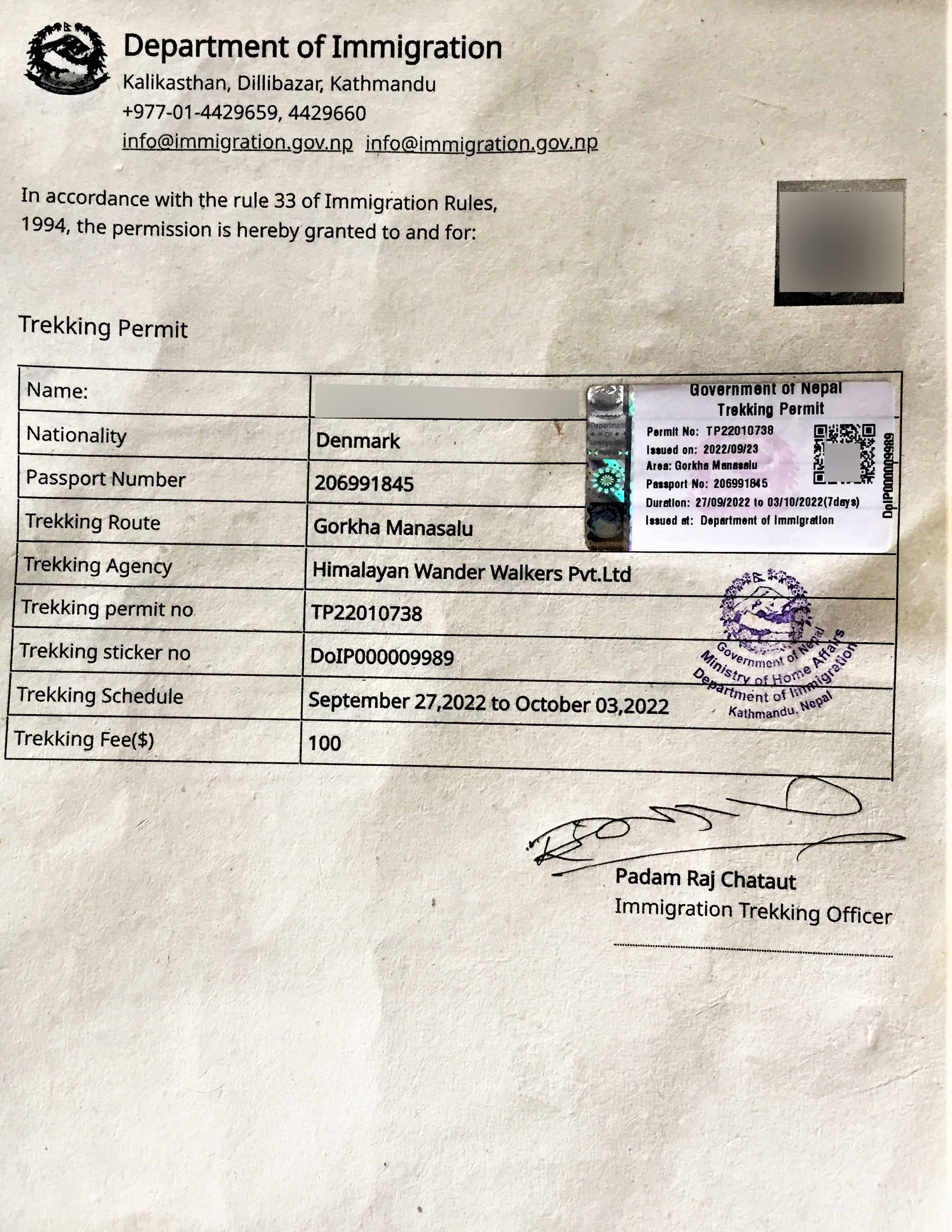
2) Manaslu Conservation Area Permit (MCAP)
The second permit that you need for trekking in the Manaslu region is the Manaslu Conservation Area Permit (MCAP), which costs about USD 30 (NPR 3000) for foreigners and USD 10 (NPR 1000) for SAARC. The cost of a single-entry MCAP permit remains the same for all seasons.
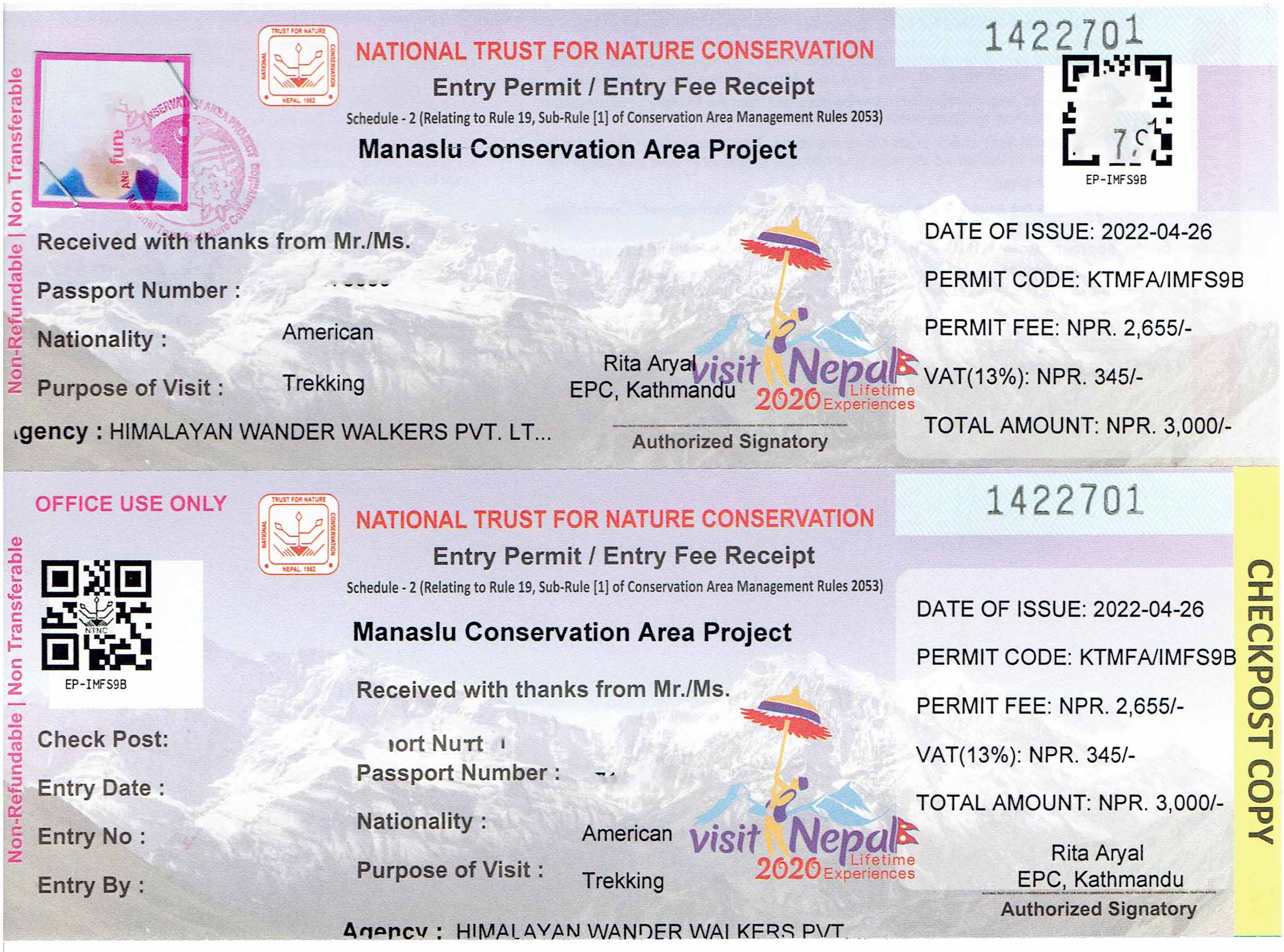
3) Annapurna Conservation Area Permit (ACAP)
Annapurna Conservation Area Permit is also known as ACAP. ACAP permit is similar to MCAP, but it is only required for those trekkers who are crossing Larke Pass and exiting from Dharapani of Manang district. Manang falls under the Annapurna area, and it requires ACAP for all trekkers. The price of ACAP is also about USD 30 (NPR 3000) for foreigners and USD 10 (NPR 1000) for SAARC.

4) Entrance Fee by Local Government
Every visitor must pay NPR 1000 during their trek at Jagat, which is a new rule implemented in 2024. This is a new entrance fee collected directly by a local government representative.
Note: Those who are trekking in Manaslu and retracing the same route to Jagat, Macha Khola, and Soti Khola don’t need an ACAP permit.
2. Starting and Ending point for Manaslu Circuit Trek?
You might have a question: Where do I start and finish my Manaslu Circuit Trek? Generally, many trekkers prefer to do their Manaslu Circuit Trek anti-clockwise. The reason to choose an anti-clock route for the Manaslu Trek is that you will easily acclimatize to the altitude, and the clockwise route is harder between Bimthang and Larke La Pass, where you need to climb for hours through a steep rocky trail.

Getting to Manaslu
The Manaslu trek starts by taking a local sharing bus or a private 4x4 jeep from Kathmandu to Macha Khola, which takes about 9-10 hours by road. Previously, the trek started from Soti Khola, but now everyone starts their trek from Macha Khola because of the newly built road.
If you are doing the Manaslu Circuit Trek, then you will cross the Larke La pass and then descend to Bimthang. From Bimthang, the trekking trail continues until Dharapani, where you will join the Annapurna Circuit Trekking Trail. From Dharapani, the local jeeps are available, which will take you to Besisahar, the entry point for the Annapurna Circuit Trek and the exit point for the Manaslu Circuit Trek. From Besisahar, regular buses for Kathmandu and Pokhara are available.
3. Manaslu Circuit Trek day by day itinerary

Day 01: Drive from Kathmandu to Machhakhola ( 870 m)
Manaslu Circuit Trek starts with driving from Kathmandu to Machakhola, which takes about 9–10 hours in a private Jeep and 12 hours in a local sharing bus. The drive from Kathmandu to Dhading Besi on a nice, paved road enjoying the views of the hilly areas, terraces, fields, and rivers will continue further till Arughat Bazaar. Then you will join the dirt road that leads to Sotikhola and Machakhola. The total driving distance from Kathmandu to Machakhola is 154 km.
Overnight at teahouse/lodge.
Day 02: Trek from Machakhola to Jagat (1340m) 6-7 hours
The second day from Kathmandu is your first trek day of a Manaslu Circuit Trek. You will have breakfast around 7:00 AM and then start the trek. From Machhakhola, you will follow a narrow trail that takes you to Tharo Khola and finally to Khorla Besi, passing the suspension bridge on your left side. After a few ascends and descends, you will reach Tatopani, where you will find a natural hot spring. You can spend some time resting and checking the hot spring. We climb another ridge and cross the Budhi Gandaki on another suspension bridge, and you will reach Doban. After a few minutes of walking, you will meet another bridge, and then the trail leads to Thado Bharyang. There is a landslide trail before the Yaru Bagar. Once you reach Yaru Bagar, then you will see the cantilever bridge that hangs on the cliff of the Budhi Gandaki River on your right side. Then we cross the west bank of Budhi Gandaki, climb over a ridge, walk on the newly constructed road for 15 minutes, and then you will reach Jagat.
Overnight at Teahouse/Lodge.
Day 03: Trek from Jagat to Deng (1860m) 6-7 hours
As usual, after your breakfast at Jagat, you will walk on the stoned paved trail within the village, and then you will cross the suspension bridge where you will witness two beautiful waterfalls that join with the Budhi Gandaki River. Before, there was a rocky ridge, but now it turns into a road that leads to Salleri and Sirdibas. You will continue to Ghatta Khola and then walk upstream through a long suspension bridge to reach Phillim, a Gurung village. In Phillim, there is a permit checkpoint for conservation and special permits. After the village of Phillim, you will reach Chisapani, where you will have lunch, and continue your trip, passing Ekle Bhatti and the suspension bridge, where you will see the Tsum Valley trail on the right side in the east direction. Then you will walk through the bamboo forests and reach the Deng River. After crossing the river, we reach the tiny Deng village.
Overnight at teahouse.
Day 04: Trek from Deng to Namrung (2,630m) 6-7 hours
On day four, the trail crosses the Budhi Gandaki and then climbs to Rana. After Rana, you will walk through the forest and painted stoned Mani walls, from where you will reach Ghap village. Here you must be extra careful as there is a landslide on the trail. Many trekkers skip Prok village and trek directly to Namrung. If you take a trail to Prok, then you will witness the beautiful views of Siring Himal in the northeast direction. We follow the river, crossing it at many places and passing through dense forests and gompas along the way. After crossing the river at a gorge, the trail becomes level, and after a last steep climb, you will reach Namrung, where you will have the best viewpoint for Siring and Ganesh Himal as well as Mt. Himal Chuli.
Overnight at teahouse.
Day 05: Trek from Namrung to Lho (3180m) 3½ -4½ hours
Beyond Namrung, the trek enters the Upper Nubri Valley, where the dialect changes to a form of Tibetan and most of the people are in Tibetan attire. As you walk further, you will notice Kani (the entrance gate to the village designed and built in Chorten style) with Buddhist murals just before the Sho village (2960 m). When you reach Sho, the views become wider, where you will see different mountains like Manaslu, Manaslu North (7157 m), and Naike Peak (5515 m). After a short trek from there, you will reach Lho village.
Overnight at teahouse.
Day 06: Trek from Lho to Samagaun (3530m) 3-4 hours
This day is short compared with other trek days. The reason behind the short-day trek is the altitude. The next morning, you will start with a short trek because of the altitude reasons. The trail is easy, but you are walking above 3000 meters in height. After breakfast, the easy trial leads to Shyala (3520 m). From Shyala it will take about one hour to Sam again. Sam again is the biggest village in Upper Nubri Valley, which is busy during the Manaslu expedition season. In Samagaun, you will see the breathtaking view of sunrise over Mount Manaslu.
Overnight at teahouse.
Day 07: Acclimatization and Exploration Day at Samagaun
All the trekkers keep one extra day at Samagaun for acclimatization and exploration, as many face altitude sickness from here. During the acclimatization day, you can do side treks to different places such as Manaslu Base Camp (4900 m), Birendra Tal (3450 m), Pungyen Gompa (4070 m), and Milarepa Cave located in the north of the Birendra Lake. Even walking through the village will provide you with an opportunity to learn about the people and lifestyle there.
Overnight at teahouse.
Day 08: Trek to Samdo (3860m) 2-3 hours
Today is also a short trek to Samdo. From Samagaun, you will reach Samdo by lunchtime. You will follow the Budhi Gandaki River and pass through the yak pasture and long stoned Mani walls. This trail leads to Larke La Pass. You will spot a Kani right at the beginning of the village. This village is the last settlement of the Nubra Valley.
Overnight at teahouse.
Day 09: Exploration Day in Samdo Village
Today is your second acclimatization day before pushing up to Larke La Pass. In Samdo, you will trek to the Nepal-Tibetan border for acclimatization. That route is used for trading between Tibet and Nepal. From the trail, you will see Manaslu, Simrang, Hiunchuli, Ngadi, Larkye Peak, Cheo, and possibly Kang Guru behind the pass. You may also encounter yak herders who stay there during the summertime. Another option for a side trek is Fukang Glacier, which lies south of Samdo village, a perfect picturesque landscape.
Overnight at teahouse.
Day 10: Trek from Samdo to Dharamsala (4480m) 2 ½ Hours
Dharamsala is also known as Larke Phedi in Nepali, which is just a lunchtime camp when you walk from Samdo. Here you will spend one night before crossing Larke La Pass. Before, there was only one teahouse with limited rooms for trekkers, but now there are more lodges that provide better rooms and food than the previous one. It will take a maximum of 2 and a half hours of walking from Samdo. In the afternoon, you can hike to the small pass that is above the tea houses or just relax at the tea house.
Overnight at teahouse.
Day 11: Trek from Dharamsala to Bimtang (3720 m) through the Larke pass (5160m) 8-9 hours
Today is the biggest day of the Manaslu Circuit trek, where you will cross one of the longest passes of Nepal above 5000 meters. Everyone wakes up early in the morning, around 4 am, to set off for Larke La. Today your breakfast will be very early as the trek starts before the dark breaks. The morning is really cold and windy in Larke La until sunrise. So, prepare well with your gear and equipment. The climb is not steep, but it’s exhausting because of the latitudes. After passing the valley and clear glacier lake, you will ascent to the small stoned shelter, a tea house that is open during the season. If the tea house is open, try to take some tea or black coffee to avoid dehydration. After the tea house, you will hike to the main Pass of Larke, which is marked by the Signed Board, through the mountains of glaciers, which become quite steep a few minutes before the pass. Here, don’t forget to take your epic photo. After the pass, the trail is very steep downhill to Bimtang, which takes about 3 hours of walking. The views of the mountains are amazing, as you will see them in all directions. In Bimtang, many trekkers celebrate their successful trek over the Larke La Pass.
Overnight at teahouse.
Day 12: Trek from Bimtang to Gho (2560 m), 4-5 hours
Today you will start your trek after breakfast. The breakfast time will be as normal around 7 am. Enjoy the splendid views of the mountains that are around the Bimtang and then trek down to Gho. Today is an easy and short day. After a few minutes of walking, you will reach the river with a wooden bridge where the Annapurna Conservation Area and Manaslu Conservation Area separate. The trekking trial will be of high pasture and rhododendron forest. When you pause and look back on your trail, you will spot the Manaslu West face through the narrow valley, forest, and fields before making a climb to the river bank that leads to the village of Gho.
Overnight at teahouse.
Day 13: Trek from Gho to Dharapani (3-4 hours) and drive to Besisahar (760 m).
After breakfast, you will trek through a stone-paved trail of the village. After the village, you will cross the river and pass by Kani, the village entrance gate of Thonje village. After passing through a police checkpoint, we make our way towards Dharapani, from where we enter the Annapurna circuit section. From Dharapani, we take a Jeep or bus from Dharapani to Beishar, which takes 4-5 hours.
Overnight at teahouse.
Day 14: Drive back to Kathmandu from Besishar
We drive along the banks of the Marsyangdi and Trishuli Rivers, witnessing the beautiful scenery of rice fields, terraced farms, rivers and valleys, and refreshing views of the hilly areas and mountains. After a few hours' journey, we reach Kathmandu.
Overnight at hotel.
4. Trekking Guides and porters for Manaslu Circuit Trek
Guides and porters are the real heroes of the Nepal Himalayas, who are popular for their sincere and hardworking jobs in the high altitudes. They play a vital role in successful trekking in the Manaslu Region.
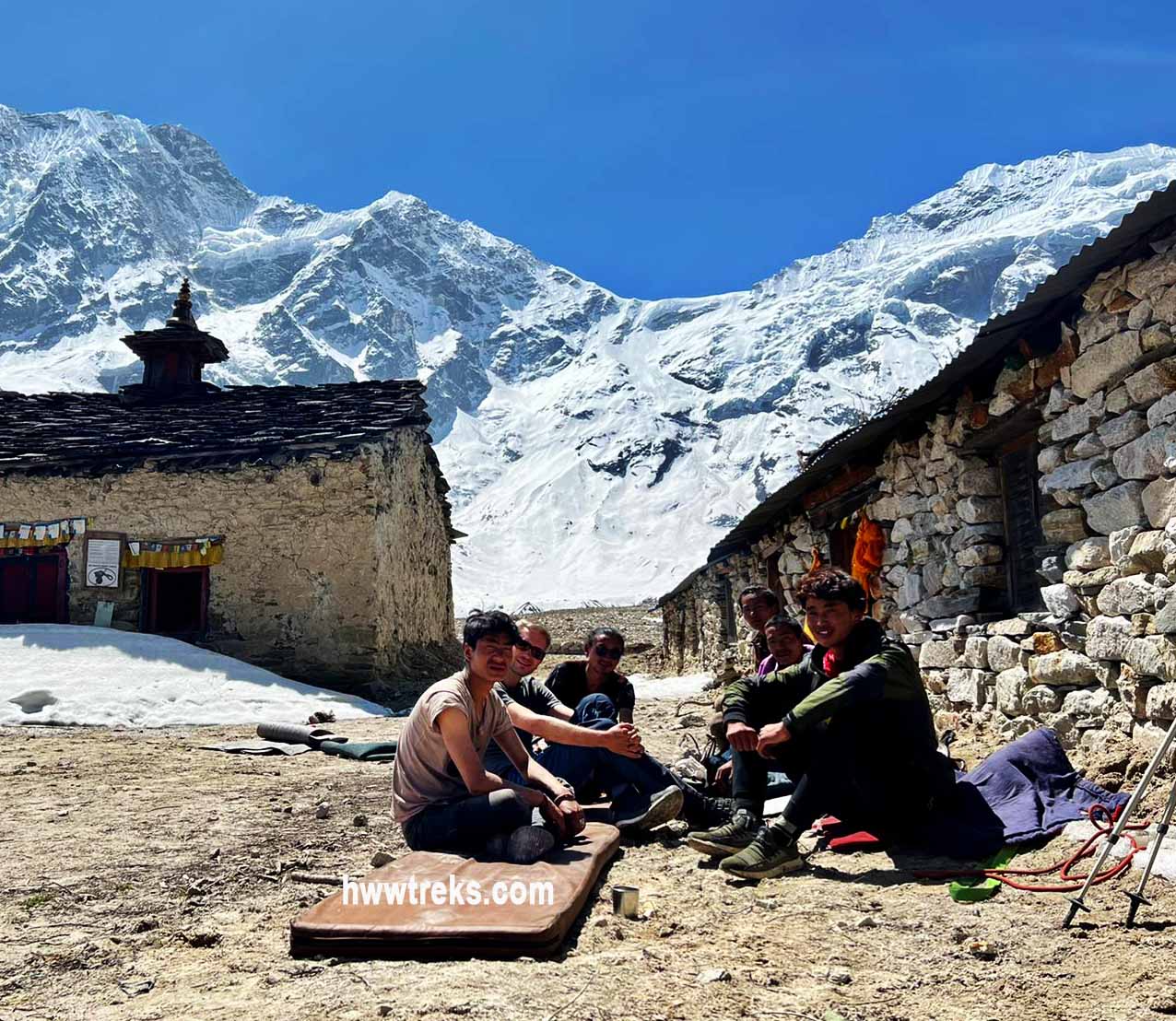
Manaslu Region is a restricted area that requires a licensed guide for all trekkers as it is compulsorily regulated by the Nepal government. Hiring a guide for Manaslu Trek is always safe and has many advantages. Trekking with a local guide is key to succeeding in your trek without any hassle. You will be more comfortable, informative, and secure on all sides during your trek.
Porters for the Tsum Valley trek are preferred by many trekkers, but still, it is optional. Porters are the right choice for those who like to trek in light and comfort. Trekking porters in Nepal have a unique nature of carrying heavy enough luggage for trekkers in high altitudes where there are thin and hard climbs. In general, a porter can carry the luggage of two trekkers with a maximum load of 10 kg from each trekker, which makes 20 kg in total.
The Himalayan Wander Walkers’ energetic and veteran trekking field team (guides and porters) are our most respected staff, who are passionate and dedicated individuals. Our mountain heroes had sacrificed more than enough to lead many successful treks in the Himalayas. We have our local guides and porters who are originally from the Manaslu Region.
5. 9 Reasons to choose Manaslu Circuit Trek
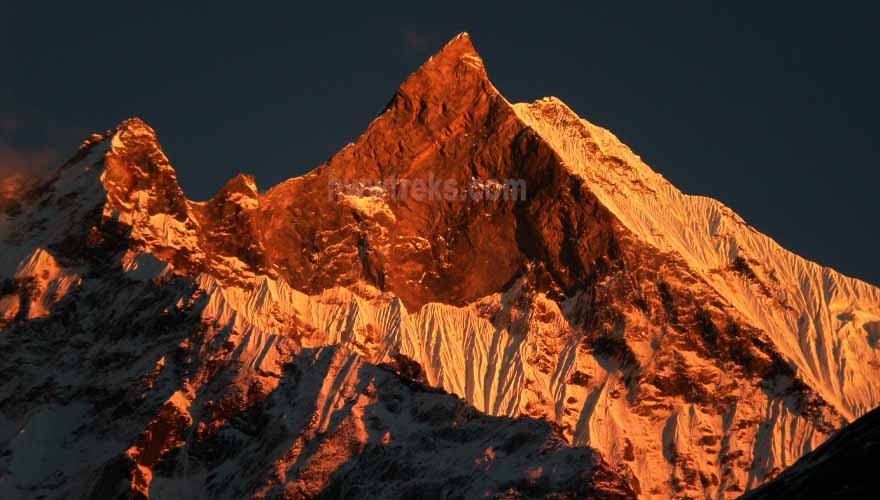
There are plenty of reasons to choose the Manaslu Circuit Trek among many treks in Nepal. All our reasons are truly based on the feedback that we got from our previous clients who had trekked to the Manaslu region with Himalayan Wander Walkers.
Here are 9 reasons to choose the Manaslu circuit for your next trek in Nepal.
1) Picturesque Landscape
Even if you write a whole book about the landscape of the Manaslu Region, it will not be enough to describe it. From the first day to the last day of your trek, you will find different landscapes each day. The low land of Gorkha, the narrow valley in the lower part of Nubri, and the mountains surrounding the villages of Upper Nubri will offer you breathtaking views. The pleasant walk through the Manaslu Conservation Area exploring the rhododendrons, wildlife, wildflowers, stunning mountains, and precarious bridges will never fail to encourage your trek unless you are physically weak.
2) Less Crowded than Annapurna and Everest Regions
You might have heard of trekkers’ traffic on the trail to Everest Base Camp and Annapurna. In the Manaslu region, you will not see a crowd like those in Everest. It is never fun if there are too many people on the same trail. There are three reasons for less trekking in the Manaslu Region. The Manaslu Trek requires a restricted permit, and it is issued only by the immigration office through a registered trekking company. There must be at least two trekkers to obtain the permit. The other reason is that Larke la Pass is challenging and considered a hard trek. The last reason is time. The Manaslu Circuit trek requires more time than the Langtang and Everest Region trek.
3) Eighth Highest Mountain in the world
The world’s 8th highest mountain, Manaslu (8163 m), is located in this region. That’s why this region is named Manaslu. While you trek in this region, you take the anti-clock route, which circles Mount Manaslu from east to west. Manaslu was first climbed on May 9, 1956, by Toshio Imanishi and Gyalzen Norbu, members of a Japanese expedition. Manaslu lies in Thoche, Dharapani, and Samagaun Village Development Committee of Manang and Gorkha Districts in the Western Development Region of Nepal. It is open for expeditions. It takes approximately 65 days to climb Manaslu Peak. The total climbing route length is 12.2 km from the base camp. The nearest settlement to the Manaslu peak is Samagaun, at a distance of 1.9 km.
4) Alternative Trek for Annapurna Circuit trek
The Manaslu Circuit trek used to be only a camping trek in the past, but now it is easier as the trail and tea houses are greatly improved. Most of the trekking trail in the Annapurna area is turned into dirt roads for vehicles, and it has shortened the duration of the trek. In terms of difficulty level, Larke La Pass is more challenging and longer than Thorang La Pass. The views from the Larke La Pass are spectacular, and it provides better views than the Thorang La Pass.
5) Hassle-free from domestic flights
Trekking in Manaslu does not require any domestic flights like in Everest, Kanchenjunga, and Dolpo. Sometimes domestic flights face lots of problems, such as flights being canceled due to bad weather. During the season, it is difficult to get a flight ticket. All the domestic flights for Mountains are the small ones with a capacity of carrying a maximum of 16–18 passengers in a single flight. If you are planning to trek in Manaslu, then you will save your costs, and it is hassle-free from domestic flights.
6) Cultural Variety
Manaslu Trek has all the elements of other treks in Nepal, including Hindu and Buddhist culture. In the Manaslu Circuit trek, you will witness many Buddhist and Hindu monuments like Kani Gates, ancient monasteries, stoned Mani walls, Chorten, shrines, and Mandir (Hindu Temple). The Gurung ethnic people in the lower part of the Manaslu Region mostly respect and practice Hinduism. While you trek higher, you will find Nubripa, the indigenous people of Upper Manaslu. They speak the Nubri language, which is almost similar to Tibetan. Losar and Yarkyi are the most popular festivals in Nubri Valley, and Tamu Losar is the biggest event of Gurung in the lower part of Manaslu. The majority of the people here are Nubripa, Tsumpa, and Gurung. Besides these three, you will also see people from different ethnicities, such as Chhetri, Brahmins, Thakalis, Magar, and New communities, residing in the Manaslu region.
7) Affordable trek and cheaper permits
All Treks of the Manaslu Region are considered not pricy trips because they are teahouse-based treks where you do not need many crew members like in a camping trek. Other restricted treks are very expensive in terms of the permit fee, where an individual trekker needs to pay USD 500 only for a permit. The Upper Mustang and Upper Dolpo permits are five times more expensive than the Manaslu permit. Many remote treks in Nepal are accessed only by domestic flights, whereas trekking in Manaslu can be easily reachable by local buses or private jeeps directly from Kathmandu, which helps to minimize your travel costs.
8) Guided trek
All the restricted trekking areas of Nepal require a licensed guide, and Manaslu is also one of them. If you are planning to do the Manaslu trek, you need to trek with a guide. So, find the right guide who is licensed and experienced in the specific trekking area where you have chosen to do the trek. If you are buying a guided trek, then your trip will be hassle-free, which will turn into a memorable trip that will cherish in the future.
9) Tea house-based Trek
Trekking around the Manaslu region was only possible through an organized camping trek. But now you don’t need to do a camping trek unless you are climbing Mount Manaslu. Before COVID-19, there was only one tea house at Daramsal (Larke Phedi), which was the worst overnight camp during the Manaslu Circuit trek, and there were not enough rooms. These days you can find improvement in all overnight trekking places, better rooms, and better food. Even in Dharamsala, you can find more tea houses with proper rooms. Because of the improved facilities in the local tea houses of the Manaslu region, many trekkers prefer to do tea house treks.
6. Best treks in Manaslu Region
1) Manaslu circuit Trek

Manaslu Circuit Trekking is one of the best treks in Nepal, regarded by many trekkers. Manaslu circuit trek can be easily done in a teahouse style without the expensive camping trip. This trek comprises sub-tropical Himalayan foothills to arid Trans Himalayan high pastures bordering Tibet and offers an astonishing view of the increasingly mountainous landscape, including a high pass crossing at Larke La. This trek is both geographically and culturally extraordinary. The residents of Nubri (the western mountains), a region known for Upper Buri Gandaki, are Tibetan immigrants from decades ago. They have their spoken language, dress, and customs, which are almost nearly Tibetan. There is still continuous trade between Nubri and Tibet; for instance, Chinese beer and candies are found more frequently than Nepali ones. In this region, Tibetan culture and religion have a strong influence; most places have Tibetan names with the meaning behind every name. The trekking route follows the ancient salt trading route along the Budhi Gandaki River. Trekking through the green forest, several gorges, beautiful waterfalls, typical villages, centuries-old monasteries, and the turquoise lake (Birendra Tal)
Outline itinerary of Manaslu Circuit Trek
Day 01: Drive from Kathmandu to Machhakhola (870 m) 9 hours
Day 02: Trek to Jagat (1340m), 6-7 hours
Day 03: Trek to Deng (1860m), 6-7 hours
Day 04: Trek to Namrung (2,630m), 6-7 hours
Day 05: Trek to Lho (3180m), 3-4 hours
Day 06: Trek to Samagaun (3500m), 3-4 hours
Day 07: Acclimatizing day at Samagaun.
Day 08: Trek to Samdo (3860m), 2-3 hours
Day 09: Trek to Dharamsala (4480m), 2 & half hours
Day 10: Cross the Larke pass (5213m) and trek down to Bimtang (3720 m), 8-9 hours
Day 11: Bimtang to Gho (2560m), 4-5 hours
Day 12: Trek to Dharapani (3-4 hours) and drive to Besi Sahar (760 m).
Day 13: Drive back to Kathmandu from Besishar.
2) Tsum Valley Trek

Tsum Valley Trek was a restricted area of the Gorkha district until 2008, when it was opened for trekking for the first time. This secluded valley was visited by many foreigners from Finland, Australia, Canada, and the United States in 2009 and became one of the most popular trekking destinations in Nepal for all trekkers from different nations. This valley of Tsumpa, with ethnically Tibetan inhabitants, is rich in all kinds, such as magnificent mountains, Tibetan living culture, ancient Buddhist monasteries, green vegetation, fertile land, blue sheep, and Himalayan vultures. Trekking to Tsum Valley provides you an opportunity to experience the daily lives of Buddhist nuns, monks, and even the ordinary Tsumpas by spending quality time with them during your trek.
Outline itinerary of Tsum Valley Trek
Day 01: Drive Kathmandu to Machha Khola (870m), 8-9 hours
Day 02: Trek from Machha Khola to Jagat (1340m), 6-7 hours.
Day 03: Trek from Jagat to Lokpa (2240 m).
Day 04: Trek from Lokpa to Chumling (2386 m), 5-6 hours.
Day 05: Trek from Chumling to Chhokangparo (Upper Tsum) (3010 m), 3 hours.
Day 06: Trek from Chhokangparo to Nile (3361 m) and visit Rachen Monastery on the way
Day 07: Trek from Nile to Mu Gompa (3700m) 3 hours
Day 08: Trek from Mu Gompa to Chhokangparo; visit Milarepa Piren Phu Cave on the way (6-7 hours)
Day 09: Trek from Chhokangparo to Gumba Lungdang (3200m), 5-6 hours
Day 10: Trek from Gumba Lungdang to Ripchet (2470m), 4-5 hours
Day 11: Trek from Ripchet to Philim (1570m), 5-6 hours
Day 12: Trek from Philim to Machha Khola (869 m)
Day 13: Drive back from Machha Khola to Kathmandu
3) Manaslu Circuit and Tsum Valley trek
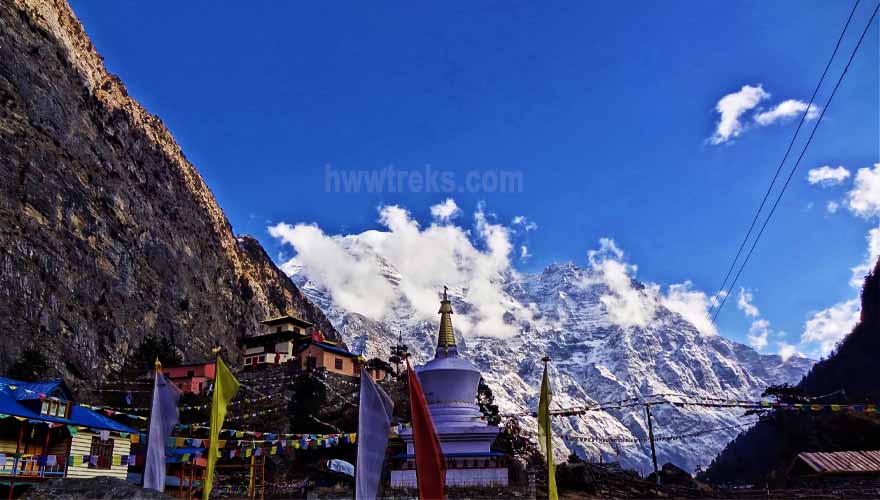
Tsum Valleys and Manaslu Circuit used to trek only with proper camping equipment in the past. But these days, tea houses are built there to provide lodging and fresh meal service to trekkers and mountaineers who wish to visit these hidden valleys of Manaslu and Tsum that lie in the Gorkha district. This combined Manaslu and Tsum Valley trek will offer trekkers the sensational view of Mount Manaslu (8th highest mountain in the world with 8,156 m), the secret Tibetan Buddhist isolated Himalayan Tsum Valley, and experience the dramatic Larke Pass of 5,100 meters.
Outline itinerary of Manaslu Circuit and Tsum Valley Trek
Day 01: Drive from Kathmandu to Machhakhola (870m), 8-9 hours
Day 02: Trek to Jagat (1340m), 6-7 hours.
Day 03: Trek to Lokpa (2240 m).
Day 04: Lokpa to Chumling (2386 m), 5-6 hours.
Day 05: Chumling to Chhekamparo (Upper Tsum) (3010 m), 5-6 hours.
Day 06: Chhekamparo to Nile/Chhule, visit Milarepa Piren Phu Cave on the way (6-7 hours)
Day 07: Nile/Chhule to Mu Gompa (3700 m), visit Dhephyudonma Gompa (4060 m) (4 hours)
Day 08: Extra day for exploring
Day 09: Mu Gompa to Rachen Gompa (5 hours)
Day 10: Rachen Gompa to Dumje (6-7 hours)
Day 11: Dhumje to Deng (1860m), 6-7 hours
Day 12: Deng to Namrung (2,630m), 6-7 hours
Day 13: Namrung to Lho (3180 m), 3-4 hours
Day 14: Lho to Samagaun (3500m), 3-4 hours
Day 15: Acclimatizing day at Samagaun.
Day 16: Samagaon to Samdo (3860m), 2-3 hours
Day 17: Samdo to Dharamsala (4480m), 2 & half hours
Day 18: Cross the Larke pass (5213m) and trek down to Bimtang (3720 m), 8-9 hours
Day 19: Bimtang to Gho (2560m), 4-5 hours
Day 20: Go to Dharapani (3-4 hours) and drive to Besi Sahar (760 m).
Day 21: Drive back to Kathmandu from Besishar.
4) Manaslu Circuit Trek with Side Trips
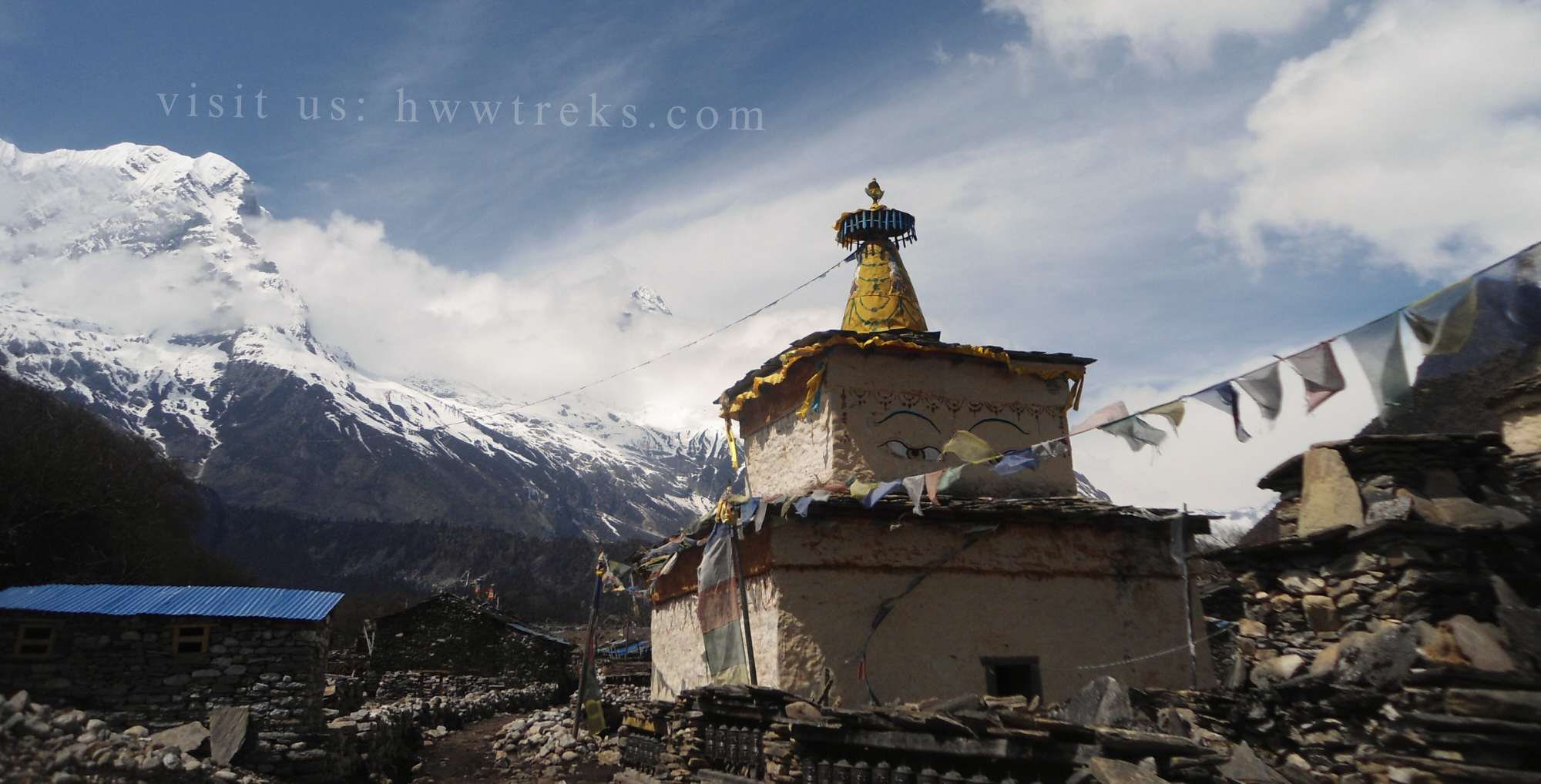
The Manaslu Circuit Trek with side trips is a stunning 20-day adventure through the heart of the Himalayas. It offers trekkers a chance to explore pristine landscapes and immerse themselves in the rich Tibetan culture. Starting with a drive from Kathmandu to Machhakhola, the trek takes you through picturesque villages like Jagat, Nyak Phedi, and Prok, where you’ll enjoy breathtaking views and experience the unique Tibetan-influenced culture. Highlights of the trek include excursions to Kaal Taal Lake (Death Lake), Hinang Gompa, and Serang Gompa, each offering serene landscapes and spiritual depth. The trek culminates at Manaslu Base Camp, providing close-up views of Mount Manaslu before tackling the challenging Larkya La Pass (5,160 m), which rewards trekkers with panoramic Himalayan vistas. This trek is the longest route in Nubri Valley, designed in an anti-clockwise direction for better acclimatization. With ancient monasteries, lush forests, and high-altitude Tibetan villages, the Manaslu Circuit Trek with side trips perfectly blends adventure, culture, and natural beauty, offering a truly unforgettable experience in the Himalayas.
Outline Itinerary of Manaslu Circuit Trek with Side Trips
Day 01: From Kathmandu to Machhakhola (870 m), 8-9 hours
Day 02: Trek to Jagat (1340 m), 6-7 hours.
Day 03: Trek to Nyak Phedi (1625 m), 5-6 hours.
Day 04: Nyak Phedi to Bhi village, 6 hours.
Day 05: Bhi village to Serang Gompa (3100 m), 6 hours.
Day 06: Visit Drupchu and explore Serang Gonpa
Day 07: Serang gompa to Ghap, 7 hours.
Day 08: Travel from Ghap to Prok Village and explore Prok Village, 4 hours.
Day 09: Hike to Kaal Taal (side trips) (3574 m), 8 hours.
Day 10: Prok village to Hinang Gompa (3100 m), 7 hours hiking
Day 11: Hinang gompa to Shyala, 6 hours.
Day 12: Shyala to Sama via Pungyen Gompa hiking (4200 m), 7 hours.
Day 13: Sama: day hiking to Manaslu Base Camp trekking (4800 m), 8 hours.
Day 14: Trek to Samdo (3860m), 2-3 hours
Day 15: Side trek to Rue La
Day 16: Samdo to Dharmasala, 4 hours.
Day 17: Dharmasala to Bhimthang via Larke Pass (5160 m), 10 hours.
Day 18: Bhimtang to Gho (2560m), 4-5 hours
5) Ganesh Himal Base Camp Trek
Ganesh Himal Base Camp of Tsum Valley lies above the Gumba Lungdang. While returning from Mu Gompa and Chhokangparo, the trail to Gumba Lungdang valley departs from Dumje by crossing the Buddhi Gandaki River in the east direction. It will take 3 hours to reach Gumba Lungdang from Dumje. There is a nunnery monastery where males are not allowed to enter inside, but these days few international trekkers stay there to observe the daily life of nuns. Morning at Gumba Lungadang is the best time to see the sunrise over Ganesh Himal. Those who want to witness the close-up views of the mountain can hike to Ganesh Himal Base Camp.
Outline itinerary of Ganesh Himal Base Camp Trek
Day 01: Drive Kathmandu to Machha Khola (870m), 8-9 hours
Day 02: Trek from Machha Khola to Jagat (1340m), 6-7 hours.
Day 03: Trek from Jagat to Lokpa (2240 m).
Day 04: Trek from Lokpa to Chumling (2386 m), 5-6 hours.
Day 05: Trek from Chumling to Gumba Lungdang (3200m), 5 hours
Day 06: Side Trek to Ganesh Himal Base Camp (4800m), 4 hours
Day 07: Trek from Gumba Lungdang to Ripchet (2470m), 4-5 hours
Day 08: Trek from Ripchet to Philim (1570m), 5-6 hours
Day 09: Trek from Philim to Machha Khola (869m)
Day 10: Drive back from Machha Khola to Kathmandu
6) Rubina La Pass Trek
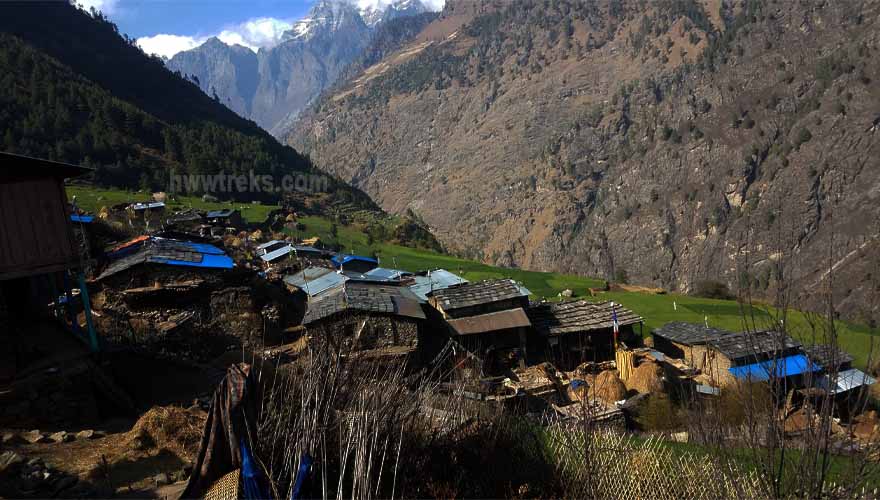
The Rubina La Pass trek is one of the less visited treks in the Lower Manaslu Region. This trek required proper camping staff and equipment. Rubina La trekking route provides trekkers epic views of the Himalayas and a variety of cultures from different ethnic groups. This trek can be done through many routes. Starting from the Barpak village is highly recommended. Barpak village is one of the biggest villages of Gurung, situated at 1900 meters in the north of the Gorkha district. This village is home to many ex-army men from Britain and India. The highest elevation of this trek is 4720 meters of Rubina La Pass.
Outline itinerary of Rupina La Pass Trek
Day 01: Drive from Kathmandu to Gorkha by private vehicle,
Day 02: Trek from Gorkha to Baluwa
Day 03: Trek from Baluwa to Barpak
Day 04: Trek from Barpak to Rupina-La Base Camp
Day 05: Trek from Rupina-La Base Camp to Kharka via Rupina-La Pass
Day 06: Trek from Kharka to Buddha Himal Glacier Camp
Day 07: Trek from Buddha Himal Glacier Camp to Nyak
Day 08: Trek from Nyak to Lokpa
Day 09: Trek from Lokpa to Chumling
Day 10: Trek from Chumling to Chhokang Paro (5-6hrs)
Day 11: Trek from Chhokang Paro to Nile (4-5hrs)
Day 12: Trek from the Nile to Mu Gompa and Chhokang Paro (6-7 hours)
Day 13: Trek from Chhokang Paro to Gumba Lungdang (5-6hrs)
Day 14: Day trip to Ganesh Himal Base Camp (7-8 hours)
Day 15: Trek from Gumba Lungdang to Lokpa (7-8 hours)
Day 16: Trek from Lokpa to Jagat (7-8 hours)
Day 17: Trek from Jagat to Machha Khola,
Day 18: Drive from Machha Khola to Kathmandu
7. Variation of Manaslu Circuit Trek
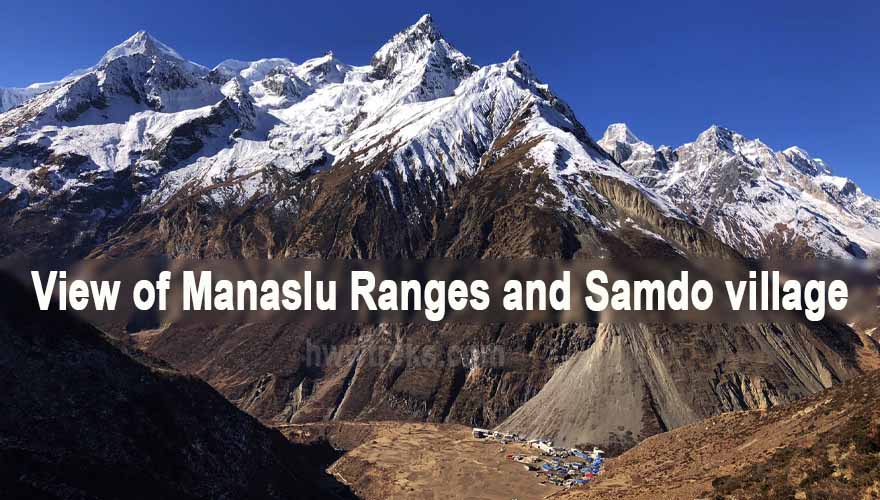
While you are trekking in the Manaslu Region and planning or looking to extend your trek by continuing to different treks, then we suggest you choose the following treks, which are interconnected and doable from the Manaslu region.
7.1 Annapurna Circuit Trek

Annapurna Circuit Trek is the most diverse trekking route in Nepal, where it connects four different districts and two different zones. It was opened for foreigners in 1980 for tourism purposes. In this trek, you will have a stunning glimpse of the Annapurna massif along with Dhaulagiri, Nilgiri, Langtang Himal, Manaslu, Machhapuchhre, Gangapurna, and Tilicho Peak. The Thorang La Pass is popular in the Annapurna region, which is located at a height of 5,416 meters, marking a border between the Manang and Mustang districts. Unlike other trekking routes, it is not only for those giant mountains but also the best in terms of the diversity in climate, altitude, landscape, trail, multi-religion, pristine little settlements, and culturally prosperous tribal groups; their culture, tradition, festival, food, dance, and dialect.
7.2 Narphu Valley trek
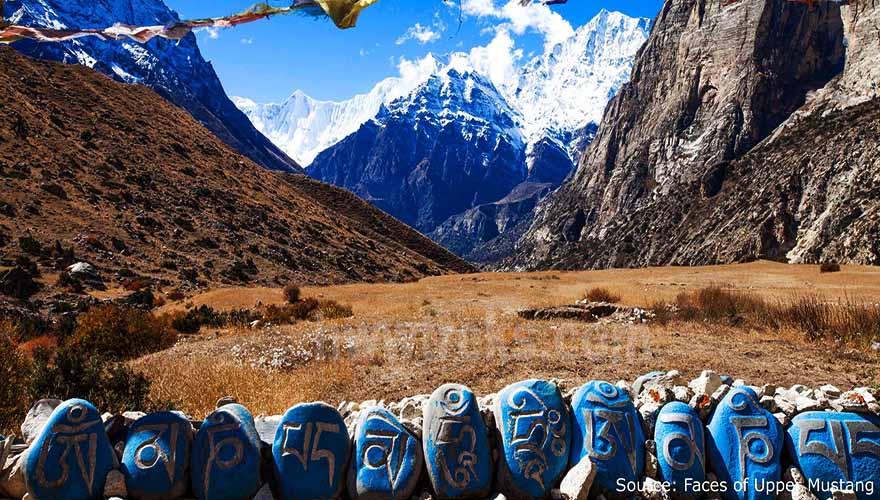
Nar Phu has spectacular mountain scenery, picturesque lowland farms, and villages with challenging passes above 5000 meters, which lead you to an amazing trip. This trek has covered the best of all, from Manang with an altitude varying from 830 meters at the lowest land of Besi Sahar to the highest at Kang La Pass with 5320 meters. Acclimatization is mandatory in this trekking because the trail leads above 5000 meters. Kang La Pass is a perfect viewpoint that offers a panoramic view of mountains and peaks. Continuing with an alternative pass of Thorang La will lead to Mustang District.
7.3 Mesokanto Pass Trek
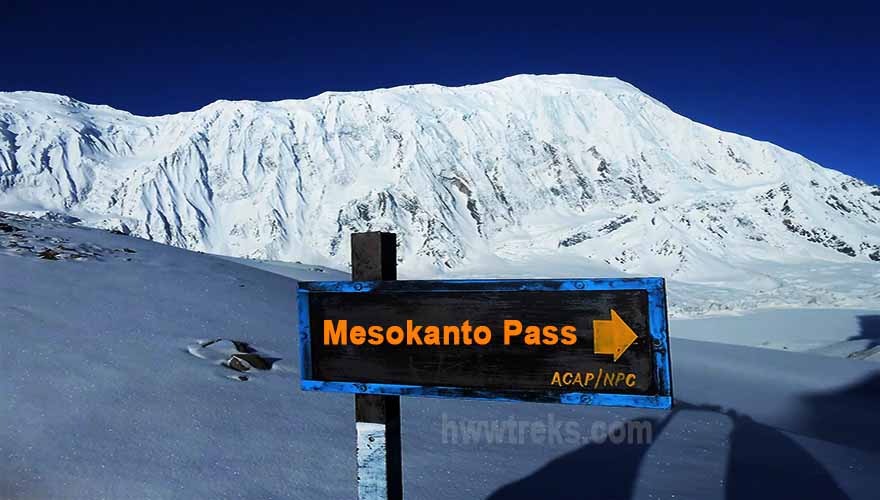
Mesokanto Pass is a perfect viewpoint that offers a panoramic view of Mt. Tilicho Annapurna massif, Mt. Gangapurna, Mt. Fishtail, Glacier Dome, and hundreds of mountains and peaks. The adventure continues in the Annapurna region with magnificent views of the Annapurna massif and Dhaulagiri massif. This is an alternative pass of Thorang La, which connects Mustang and Manang.
8. Best season for trekking in Manaslu Region
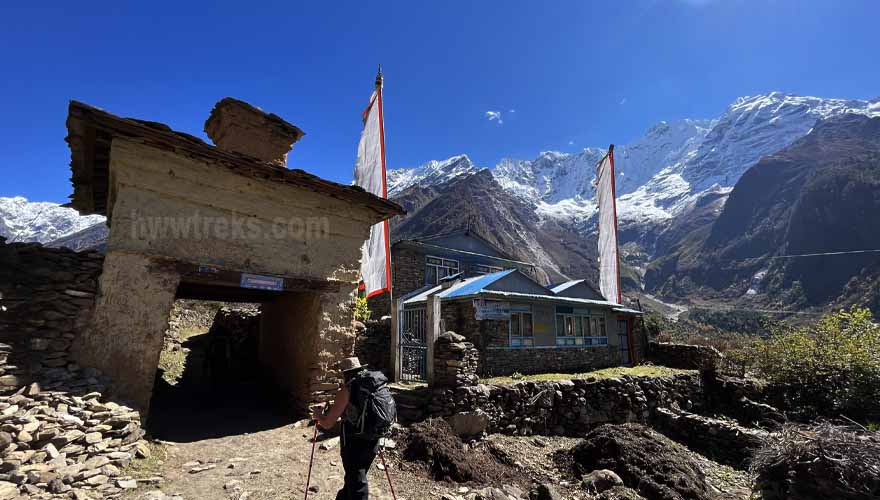
The spring and autumn seasons are the best seasons for Manaslu Trekking. Mid-summer and mid-winter are not recommended for trekking as it is too risky.
8.1 Spring season for Manaslu Trek
The months of late March, April, and May of the spring are a peak season for trekking in the Manaslu Region as the temperature gradually increases, and not yet a rainy season too. Therefore, trekking in Manaslu during spring is highly recommended.
8.2 Autumn Season for Manaslu Trek
The months of late September, October, and November are also considered the best time for trekking in the Manaslu Region, as the monsoon ends and the weather gets better when the temperature of scorching summer drops down, which makes favorable weather for trekkers to trek in the high altitude.
In Manaslu Region, few trails are very risky during the rainy season because of the heavy rain. You may face trouble with landslides and stones falling. During mid-winter, lodges in Dharamsala of Larke Phedi will be closed because of the heavy snowfall; it is too risky to cross the Larke Pass. So, always ask locals or any trekking operators for the latest updates on the trail.
9. Network and Electricity availability in Manaslu Region

The facilities of electricity and telephone network coverage in Manaslu are better than before COVID-19. In the past, solar power was widely used in all the places of Manaslu, and it is hard to charge your electronic devices during cloudy days. During that time, CDMA, or Sky Sim Card, was the only telephone service available in Manaslu, and that will not work above Samagaun. But now the time has changed, and you will get better network services. Where there is no signal for a Sky SIM card, a satellite phone was the only option in emergencies.
9.1 Telephone and Internet service in Manaslu Region
Since 2021, telephone coverage is available in the whole Manaslu region. In the lower part of Manaslu, both the Ncell and NTC (Namaste) Sim Cards are usable for telephone and Internet. Among the two of them, NTC is more useful as it works throughout the region. Most teahouses or lodges provide WIFI services to their guests with certain charges for their internet service. So, we recommend you buy an NTC Sim Card in Kathmandu before you start the Manaslu trek.
9.2 Electricity in Manaslu Region
Power is available in every village during your trek to Manaslu, but still, we suggest you take a spare battery or power bank for backup. Sometimes during the monsoon, there is a power cut due to a landslide or other reasons. In the lower part of the Manaslu region, charging your gadgets is free of charge. When you trek higher, you may need to pay for battery charging in some tea houses. The cost will not be too expensive.
10. Top tips for trekking in Manaslu Region
- If you have enough time, then the Tsum Valley Trek is recommended while doing the Manaslu Circuit Trek.
- A local guide or guide who can speak the Tibetan language is highly recommended for a better experience.
- Never plan to trek Manaslu during the monsoon and mid-winter time.
- Try to spend at least one night in any monastery to learn about the lives of nuns and monks in Tsum Valley.
- Choose a local and accredited Nepalese trekking Agency
Read Our Tsum Valley Trekking Guide here: Trekking in Tsum Valley
Review of Manaslu Trek

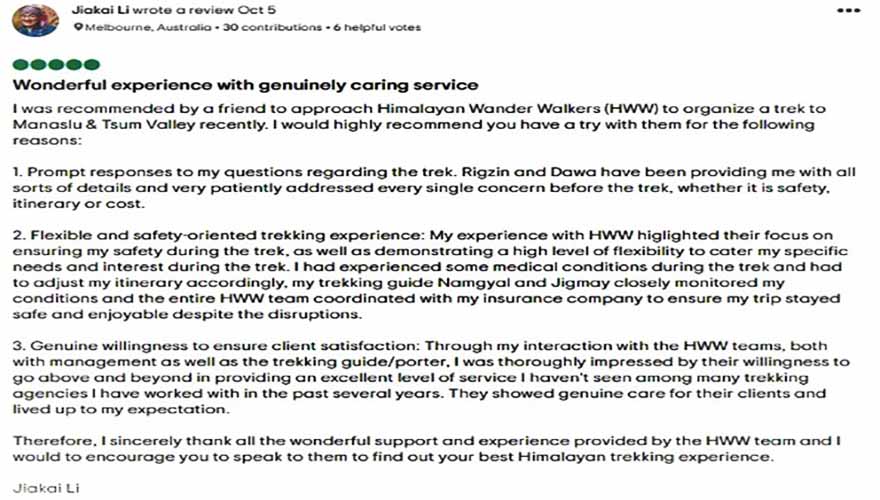
Join Our Fixed Departure for Manaslu Region Trek
- 14 Nov, 2025 - 28 Nov, 2025(Manaslu Circuit Fixed Departure Date)
- 10 Oct, 2025 - 24 Oct, 2025(Manaslu Circuit Fixed Departure Date)
- 27 Oct, 2025 - 10 Nov, 2025(Manaslu Circuit Fixed Departure Date)
- 16 Apr, 2026 - 30 Apr, 2026(Manaslu Circuit Fixed Departure Date)
- 01 May, 2026 - 15 May, 2026(Manaslu Circuit Fixed Departure Date)
- 18 May, 2026 - 01 Jun, 2026(Manaslu Circuit Fixed Departure Date)
- 20 Oct, 2025 - 04 Nov, 2025(Tsum Valley Fixed Departure Date)
Frequently Asked Questions
Find answers to common questions about our services
The Manaslu Circuit Trek difficulty is moderate to hard, considered moderately difficult since you will be traveling off the beaten path above 5000m. This beautiful trip circles Mount Manaslu (8,163m), the eighth-highest peak on the planet, while crossing the Larkya La Pass at 5,106 m. The trek involves 6-8 hours of daily walking across varied terrain, including steep ascents, river crossings, and high-altitude sections. Good physical fitness, proper acclimatization, and some prior trekking experience are recommended for this challenging but rewarding adventure around the world's eighth-highest mountain.
Yes, a licensed guide is mandatory for Manaslu trekking as per government regulations. A minimum of two trekkers and a licensed guide are required to obtain the MRAP. It is mandatory to book your trek with trekking agencies. The remote nature of the circuit, challenging navigation through diverse terrain, high-altitude risks, and cultural sensitivity in Tibetan Buddhist communities make professional guidance essential. Guides ensure safety, proper acclimatization, permit compliance, and provide valuable insights into local culture and mountain conditions.
Teahouses are the most common accommodations along the trail. These are small guesthouses run by local families offering basic rooms, simple meals, and a friendly atmosphere at every major stop like Jagat, Namrung, Lho, and Samagaun. In lower altitudes, teahouses provide single rooms with attached bathrooms, but as you trek higher, the facilities are limited to twin-sharing rooms and common toilets. Rooms include two beds with mattresses, pillows, and warm blankets.
Yes, Manaslu region treks can be customized to meet your preferences and fitness level. The standard 14-18 day circuit can be modified to include additional acclimatization days, extended stays in villages like Samagaun for cultural exploration, or side trips to Birendra Lake and Manaslu Base Camp. Whether you want to focus on photography, cultural immersion with Tibetan Buddhist communities, or combine with Tsum Valley exploration, we can tailor the experience while ensuring proper acclimatization for the challenging Larkya La Pass crossing.
Manaslu Circuit Trek: The classic 14-18 day trek around Mount Manaslu crossing Larkya La Pass (5,106m) with stunning mountain views and cultural experiences.
Manaslu with Tsum Valley: 18-23 day comprehensive trek combining the main circuit with the sacred hidden valley of Tsum, rich in Tibetan Buddhist culture.
Manaslu Circuit Trek with multiple side trips: 18-21 day adventure including a side trip for closer mountain views, glacier, villages, and monasteries exploration.
Tsum Valley Trek: 16-20 day extended trek connecting two major circuits via Larkya La Pass for the ultimate Himalayan experience.
Internet access is limited during the Manaslu Circuit trek. WiFi is available in some teahouses in lower villages like Jagat, Namrung, and Samagaon, but connectivity is slow and often unreliable. Mobile network coverage is weak and inconsistent throughout most of the circuit.
Manaslu Trek package will start from USD 1150 to USD 1800 per person, including food and accommodation during the trip, transportation, special permit, guide, porter, and hotel accommodation. Costs vary based on trek duration, service level, group size, and season. All packages typically include the required permits, licensed guide, teahouse accommodation, meals during trek, and ground transportation.
You will need the Annapurna Conservation Area Permit (ACAP), the special Tsum Valley and Manaslu Region Permit(if you visit Tsum Valley too), the Manaslu Conservation Area Permit, and the entrance fee from the local government. These permits can be obtained through a licensed trekking agency. All permits must be arranged through registered trekking agencies as individual applications are not permitted.
Essential gear for Manaslu includes warm layered clothing (down jacket, fleece, thermal underwear), waterproof jacket and pants, sturdy trekking boots, warm hat and sun hat, insulated gloves, glacier sunglasses, high SPF sunscreen, sleeping bag, trekking poles, headlamp with extra batteries, personal first aid kit, and water purification tablets. Most gear can be purchased or rented in Kathmandu. Pack appropriately for high altitude conditions and variable mountain weather throughout the circuit. Read more about trekking gear and equipment.
No questions found matching your search. Try different keywords or browse all questions above.



